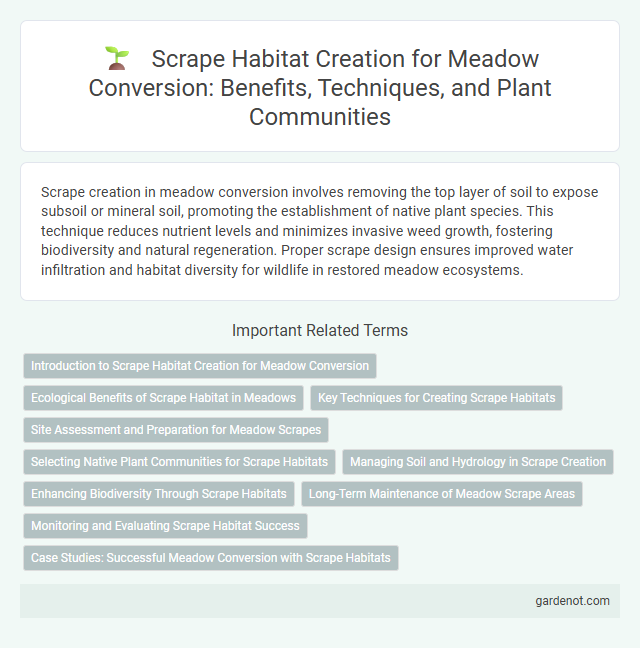Scrape creation in meadow conversion involves removing the top layer of soil to expose subsoil or mineral soil, promoting the establishment of native plant species. This technique reduces nutrient levels and minimizes invasive weed growth, fostering biodiversity and natural regeneration. Proper scrape design ensures improved water infiltration and habitat diversity for wildlife in restored meadow ecosystems.
Introduction to Scrape Habitat Creation for Meadow Conversion
Scrape habitat creation involves designing shallow depressions that hold seasonal water, providing ideal breeding and foraging conditions for wetland species during meadow conversion projects. These habitats support amphibians, wading birds, and invertebrates by mimicking natural floodplain dynamics and enhancing biodiversity. Effective scrape creation requires careful planning of hydrology, soil type, and vegetation to ensure long-term ecological benefits within converted meadow landscapes.
Ecological Benefits of Scrape Habitat in Meadows
Scrape habitats in meadows provide critical ecological benefits by creating shallow water pools that support diverse amphibian and invertebrate populations, enhancing local biodiversity. These temporary wet areas facilitate the breeding of frogs, toads, and dragonflies while attracting a variety of bird species that rely on aquatic insects for food. The presence of scrapes also promotes nutrient cycling and soil moisture retention, improving the overall health and resilience of meadow ecosystems.
Key Techniques for Creating Scrape Habitats
Key techniques for creating scrape habitats in meadow conversion involve carefully excavating shallow depressions that retain seasonal moisture and encourage diverse vegetation growth. Incorporating varying depth profiles and avoiding compaction ensures optimal breeding sites for amphibians, invertebrates, and ground-nesting birds. Strategic placement near natural water sources and native plant communities enhances ecological connectivity and biodiversity.
Site Assessment and Preparation for Meadow Scrapes
Site assessment for meadow scrapes involves analyzing soil composition, hydrology, and existing vegetation to determine optimal locations that support native wetland flora and fauna. Preparation includes removing invasive species, grading the land to create shallow depressions, and ensuring appropriate water retention for diverse habitat conditions. Properly executed meadow scrape creation enhances biodiversity by providing suitable microhabitats for amphibians, invertebrates, and plant species adapted to ephemeral wetlands.
Selecting Native Plant Communities for Scrape Habitats
Selecting native plant communities for scrape habitats enhances biodiversity by providing suitable food and shelter for targeted wildlife species. Prioritizing hydrophilic grasses, sedges, and native wildflowers in the soil profile supports natural succession and improves soil stability in scrape areas. Incorporating region-specific species like Carex spp., Juncus effusus, and Solidago canadensis promotes resilient ecosystems and attracts pollinators crucial for meadow conversion success.
Managing Soil and Hydrology in Scrape Creation
Managing soil and hydrology in scrape creation involves carefully removing topsoil to expose subsoil layers that hold moisture, thereby creating optimal wetland conditions for biodiversity enhancement. Proper contouring and grading ensure water retention and prevent excessive runoff, promoting habitats for amphibians and invertebrates. Integrating hydrological controls, such as water control structures or connection to groundwater, stabilizes water levels and supports sustainable wetland ecosystems.
Enhancing Biodiversity Through Scrape Habitats
Scrape creation in meadow conversion significantly enhances biodiversity by providing shallow depressions that collect water, attracting amphibians, insects, and bird species. These microhabitats support diverse flora and fauna, promoting ecological richness and increasing habitat heterogeneity. Implementing scrapes fosters nutrient cycling and offers breeding grounds for rare and endangered species, crucial for resilient meadow ecosystems.
Long-Term Maintenance of Meadow Scrape Areas
Long-term maintenance of meadow scrape areas involves regular monitoring to ensure successful vegetation establishment and soil stability. Proper management includes controlling invasive species, periodic re-scraping to prevent sediment buildup, and promoting native plant growth to enhance biodiversity. Consistent maintenance supports habitat diversity, benefiting pollinators and ground-nesting birds in meadow ecosystems.
Monitoring and Evaluating Scrape Habitat Success
Monitoring scrape habitat success involves regular assessment of vegetation structure, invertebrate populations, and usage by target bird species to ensure ecological objectives are met. Evaluating soil moisture levels and nutrient content provides critical data on habitat quality and sustainability, directly influencing scrape functionality. Success is indicated by increased biodiversity, stable water retention, and effective nesting site utilization documented through systematic field surveys.
Case Studies: Successful Meadow Conversion with Scrape Habitats
Case studies demonstrate that successful meadow conversions using scrape habitats significantly boost local biodiversity by creating diverse microtopographies that support native flora and fauna. Scrape creation enhances soil drainage and nutrient cycling, fostering ideal conditions for meadow species to establish and thrive. These projects reveal measurable increases in pollinator populations and ground-nesting birds, validating scrape habitats as effective tools in meadow restoration.
Scrape creation Infographic

 gardenot.com
gardenot.com